Legal Technological Innovations: 25 Years of IT and the JAG Corps
The information technology revolution lives on and continues to transform the legal practice in the Air Force.
In the Special 50th Anniversary Edition of The Reporter, Mr. John Paul Davis chronicled the birth and evolution of information technology in The Judge Advocate General’s Department and the Department of Defense in his article “Four Decades of Information Technology Excellence Leading the Revolution.”[1] Today, the “revolution” has become a transformation and Federal Legal Information Through Electronics (FLITE) is not the same as it was when it began in the 1960s or even 25 years ago.
Legal Information Technology Revolution
The Birth of FLITE
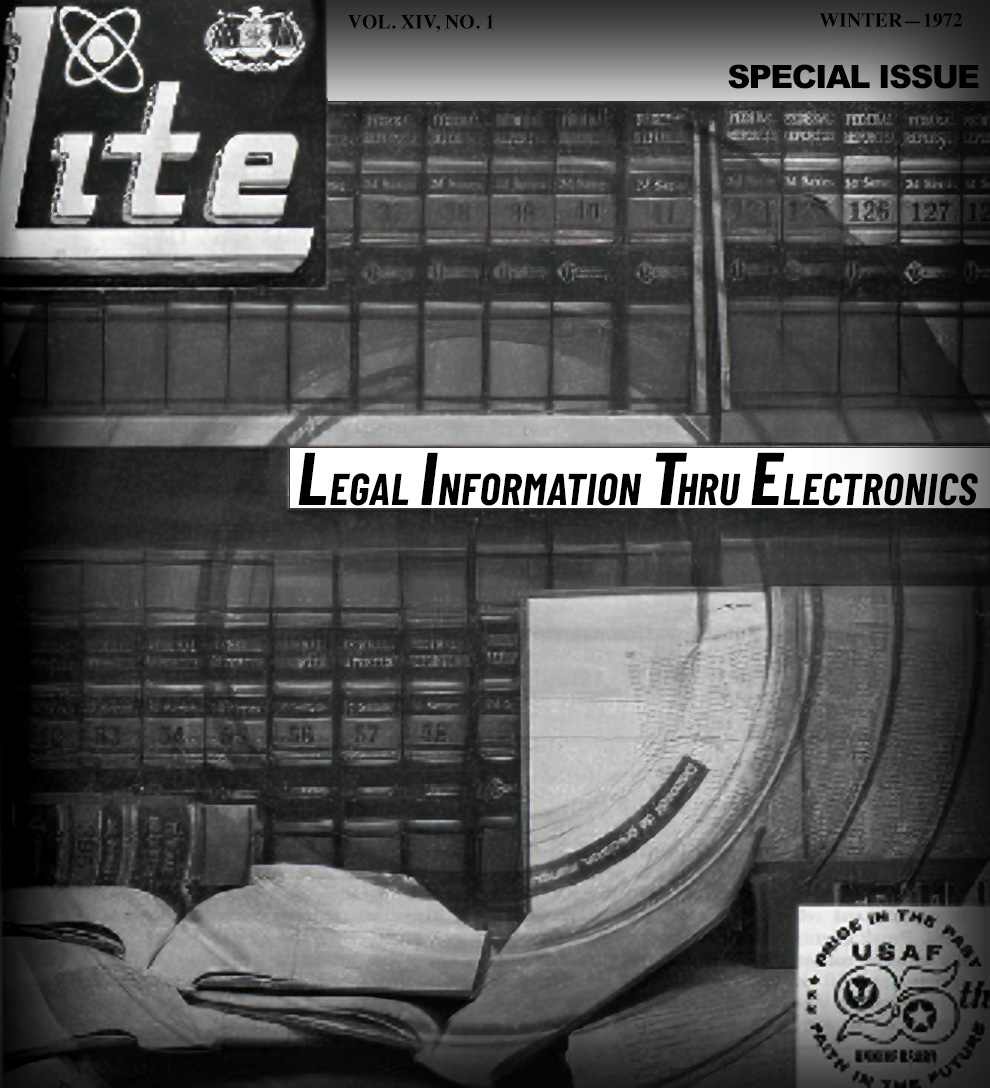
In 1961, the curiosity of the Air Force Accounting and Finance Center Staff Judge Advocate, Colonel Calvin M. Vos “…would be the shot that would begin the Legal Information Technology Revolution for the Department of Defense [(DoD)].”[2] He believed computers could be used to store and retrieve legal research materials, and on 17 July 1963, Legal Information Through Electronics (LITE) came into being by using mainframe computers at the University of Pittsburgh to store sections of the United States Code and portions of the Comptroller General decisions for electronic retrieval. The first legal research-based computer system had been born. Unlike today where a simple internet search will bring back more information than could be found in hours spent in a law library, the early days of LITE saw users across the DoD submitting written requests for legal data which would be performed by LITE attorneys and then returned to the requester. During its early days, LITE was at the mercy of others to host its legal databases, and in 1970 the contractor hosting LITE defaulted on its contract and LITE shut down. However, the LITE staff regrouped, began taking IBM courses, and was able to bring LITE back online by using Air Force-owned equipment. In mid-1974 the letter “F” was added to LITE and by direction of DoD Directive 5160.64, LITE became FLITE, “Federal Legal Information Through Electronics.”[3]
Throughout the 1970s and 80s FLITE amassed legal research materials to provide practitioners in the field with faster and more accurate results than poring over hardcopy books, and “in October 1988, FLITE deployed an online computer assisted research system.”[4] This allowed users in the field to conduct their own online legal research for the first time. This technology, using a computer modem to connect to FLITE servers, was the forerunner of what legal research on the World Wide Web would become. In 1984, FLITE became the Legal Information Services Directorate (JAS) and its mission had begun to evolve from not only providing legal research but to also managing automation.[5]
Legal Research to Computer Applications
The revolution had begun to sow its own seeds of transformation, and in addition to providing legal research, JAS began to provide computer applications designed to help legal office automation. In 1974, the Automated Military Justice Analysis and Management System (AMJAMS) was released and since 1993 has fallen under the responsibility of JAS.[6] In 1986, the Claims Administrative Management Program (CAMP), the predecessor to the Armed Forces Claims Information Management System (AFCIMS), was released. This application was a mainframe system which used key punched cards.
The World Wide Web
In 1992, JAS left Denver, Colorado, and moved to Maxwell Air Force Base (AFB), Alabama. On 1 September 1993, FLITE was relocated from a mainframe computer in San Antonio, Texas to its own servers at Maxwell AFB. JAS continued with the information technology revolution, and “in January 1996, FLITE became the first computer assisted legal research system to be accessible via the World Wide Web.”[7] By contrast, Westlaw introduced a web-based version of Westlaw in March 1999[8] and sometime in 1996, LexisNexis became accessible via the World Wide Web.[9] Toward the end of his article, Mr. Davis recognized the changing landscape of technology and wondered, “what programs will finally be completed and/or new ones added [by JAS]?” and “Will litigation support become a new mission at JAS?”[10]
Litigation Support
It was as if Mr. Davis had glimpsed the future because that was the direction JAS was headed in over the next two decades. In 1998, JAS provided emergency teams and deployers with the “Big Blue Blocks (Basic Legal Office Computer Kit).” These blue blocks supported contingency legal offices and also served as an on-scene claims office or other temporary legal activity. In addition to protecting the equipment during shipment, the container converterd to a table and chair and there were 10 of these blocks prepositioned around the world for rapid deployment.
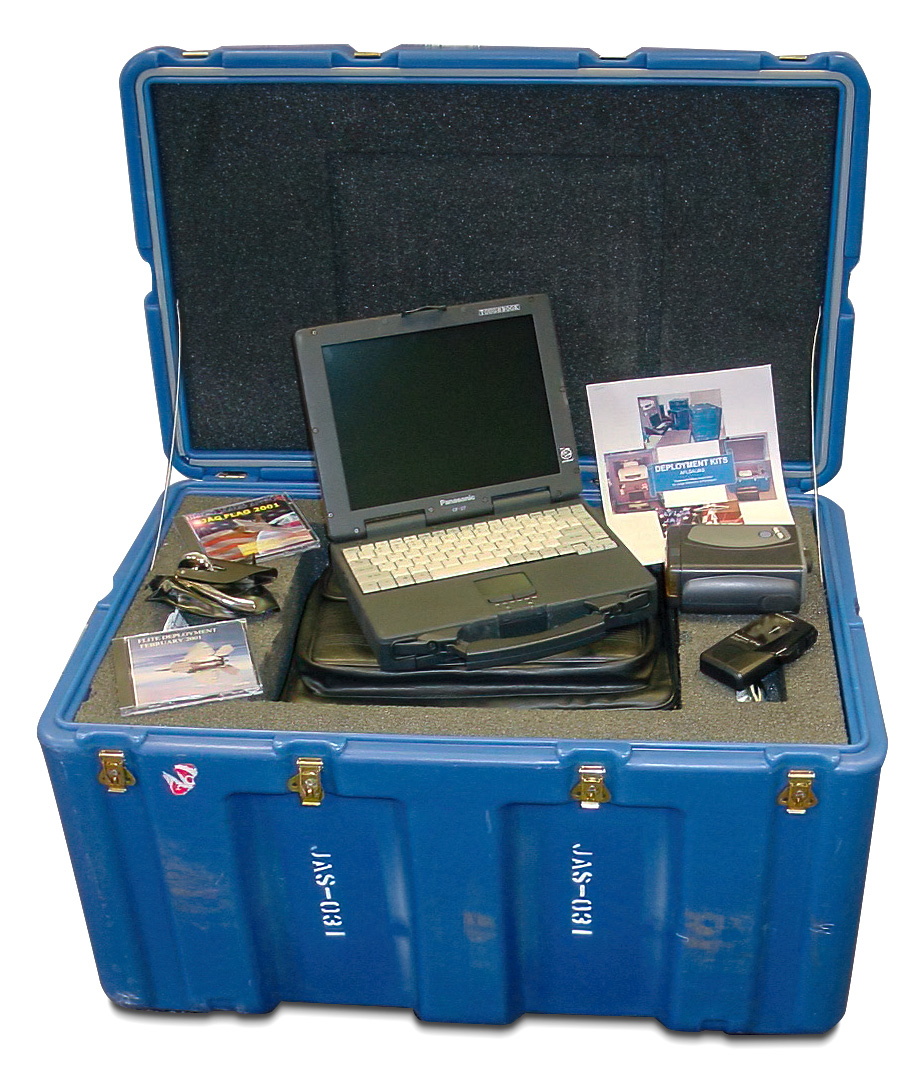
The Big Blue Block contained a ruggedized laptop, small inkjet printer, digital camera, external zip drive, mini cassette recorder, notary stamp, research software and books. (Air Force Judge Advocate General's Corps courtesy photo)
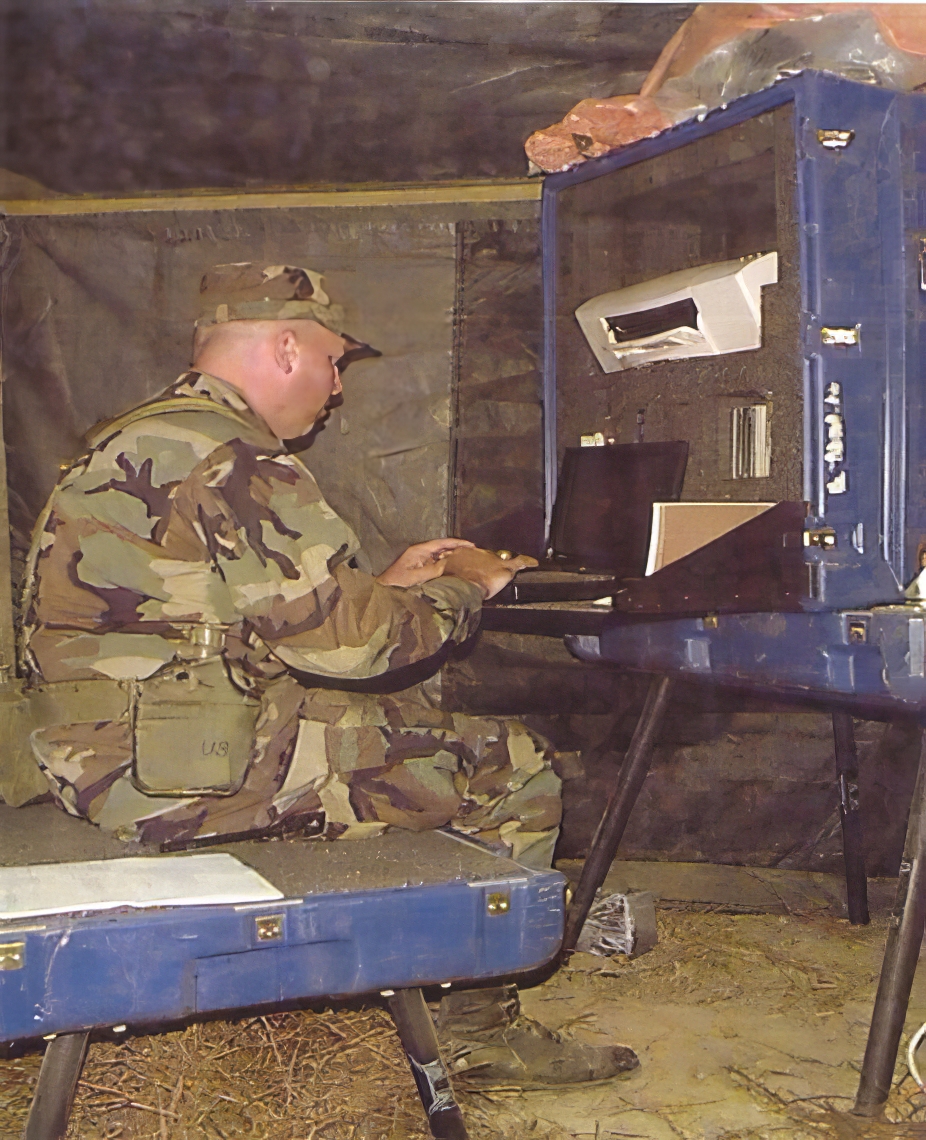
Big Blue Block in deployed environment. Container turns into table and chair. (Air Force Judge Advocate General's Corps courtesy photo)
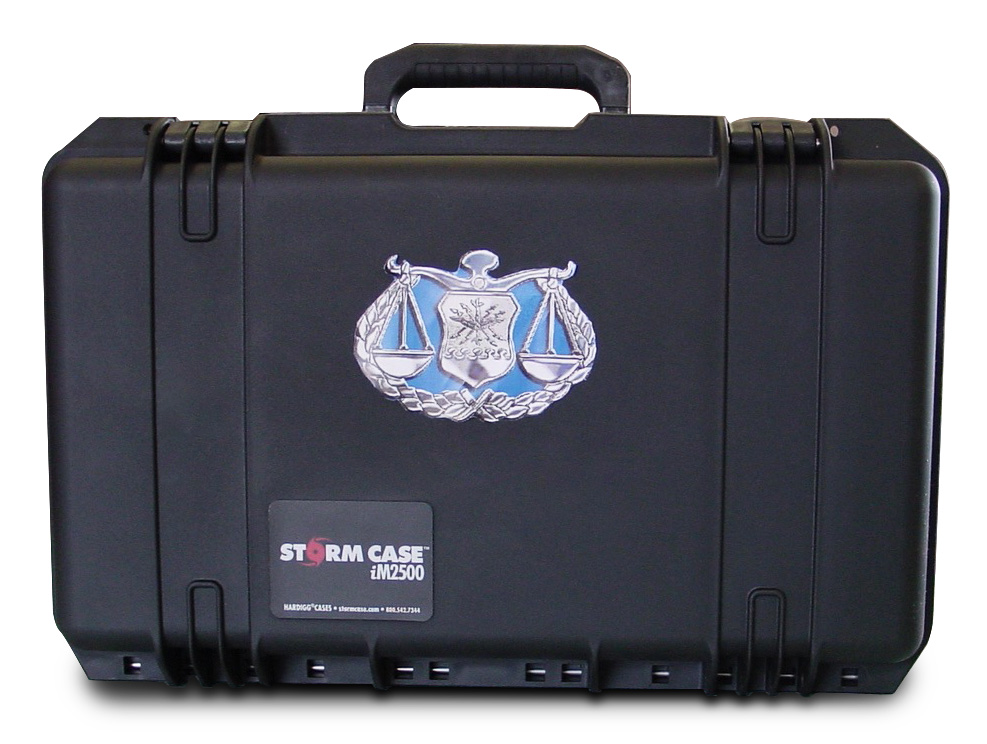
Rapid Response Kit. Lighter weight option to the Big Blue Block. (Air Force Judge Advocate General's Corps courtesy photo)
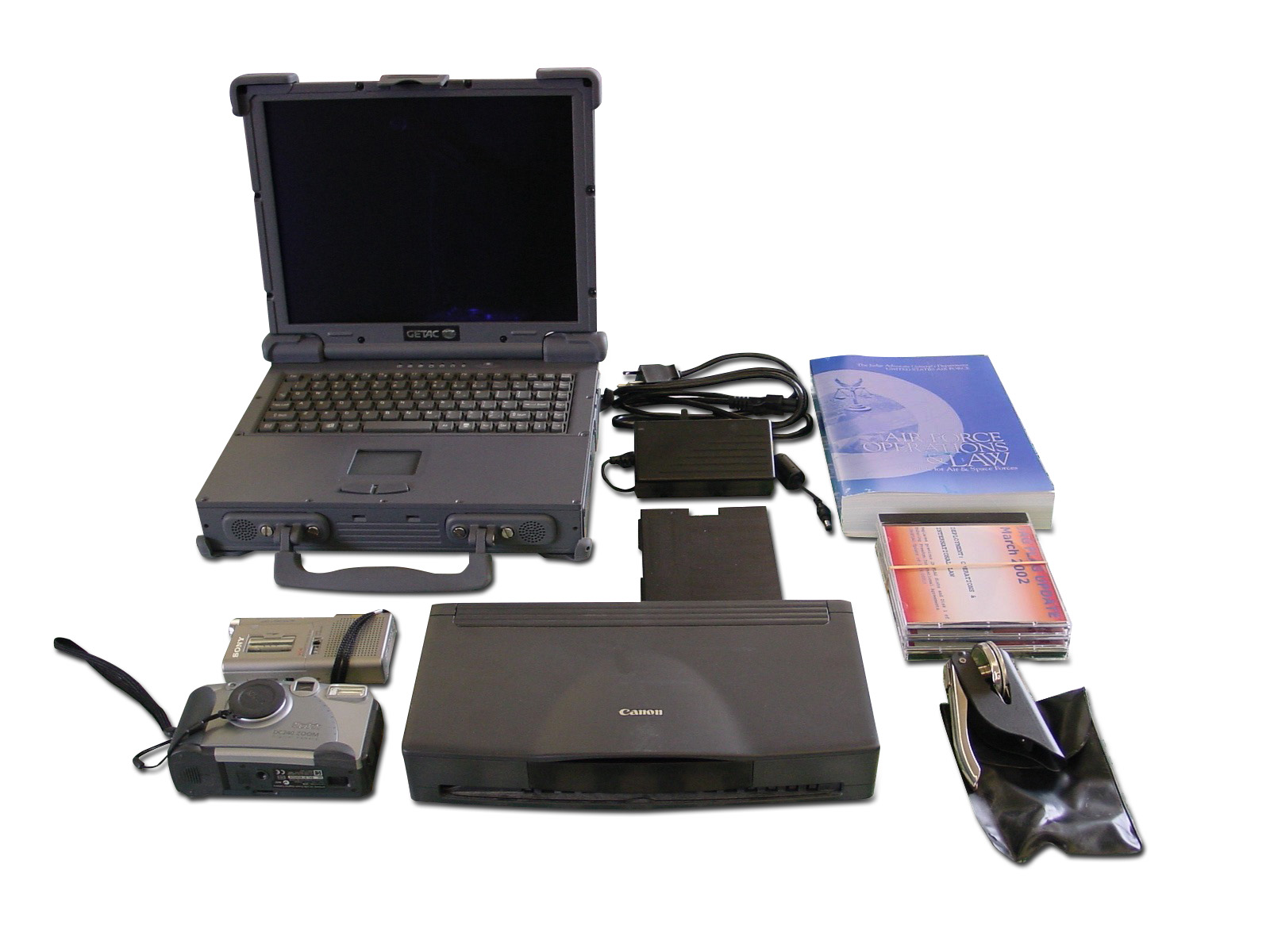
Rapid Response Kit items consisted of a ruggedized laptop, small inkjet printer, digital camera, external zip drive, mini cassette recorder, Notary Stamp, research software and books. (Air Force Judge Advocate General's Corps courtesy photo)
The legal research mission of FLITE was still present and attorneys like Mr. Ronald Bibby, Mr. Don Nolte, and Ms. Lynn Mokray provided that service to legal professionals throughout the DoD. However, instead of only searching the black letter law, JAS had implemented a search engine to crawl across the materials made available by subject matter experts on websites hosted by JAS. Labor law, contract law, environmental law, and Mr. Mark Stone’s ethics websites were all available for research purposes. FLITE attorneys also became smarter about the technology they were working with and created the FLITE interfaces and forms that users would see when they accessed FLITE on the web.
Not only was the World Wide Web exploding with content, JAS was also demoing emerging technologies, like Genesys Meeting Center, the forerunner of technologies like Zoom, Skype, Microsoft Teams, Discord, etc. Imagine the surprise of conference goers at the 2003 PACAF Staff Judge Advoate Conference when paralegals at Maxwell AFB took control of the screen and provided their briefing from over 4,000 miles away. Not only was JAS using technology to its fullest, it was also teaching how to use that technology. JAS provided week long hands on training in HTML and PHP and a special hands-on training for senior leaders in a three-day Executive Technology Course.
In 2004, The Judge Advocate General (TJAG)/FLITE homepage changed again, this time allowing users to select the layouts, the sources of law, and the links to quickly find the information which was most relavant to their practice.
In 2005, JAS took another step outside the legal research arena but back toward one of the reasons it had moved to Maxwell AFB, synergy with The Judge Advocate General’s School (AFJAGS).[11] JAS military attorneys and paralegals created the first JAG Corps learning management system, Judge Advocate Distance Education (JADE). “The JAG Corps challenges created the need for a distance learning solution that not only quickly delivered courseware but also helped develop those courses.”[12]
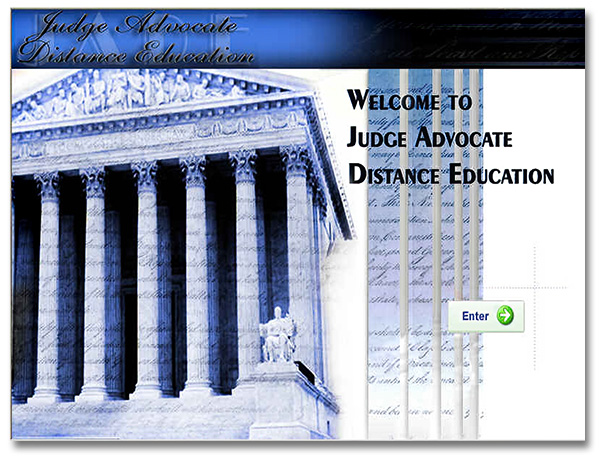
JADE, Judge Advocate Distance Education website. (Air Force Judge Advocate General's Corps courtesy photo)
Under the direction of then-JAS Director, Colonel Peter Marksteiner, JAS exploited the tools acquired to create eLearning courses to instruct Air Force legal professionals about the information technology available to help put time back in their workday. As a result of the Information Technology Stand-down Day (ITSD), JAS was awarded the 2009 W. Edward Deming Outstanding Training Award. The U.S. Department of Agriculture Graduate School annually presents the award to a federal government organization, civilian or uniformed branch of the military, in recognition of an impressive workforce development and training initiative that has measurably improved the organization's performance. Lieutenant General Jack Rives, then-The Judge Advocate General, stated, “This award recognizes the tremendous efforts of our information technology professionals and their significant impact on the Air Force mission,” and “the team [JAS] supports a variety of Air Force initiatives and has helped to transform legal operations to better align with new requirements.”[13] As information technology developed so did the possibilities of its use. JAS recognized the possibility of harnessing that power to assist the learning process of legal professionals. JADE remained the focal point of the Corps’ eLearning until 31 May 2009, when it was replaced by CAPSIL.[14]
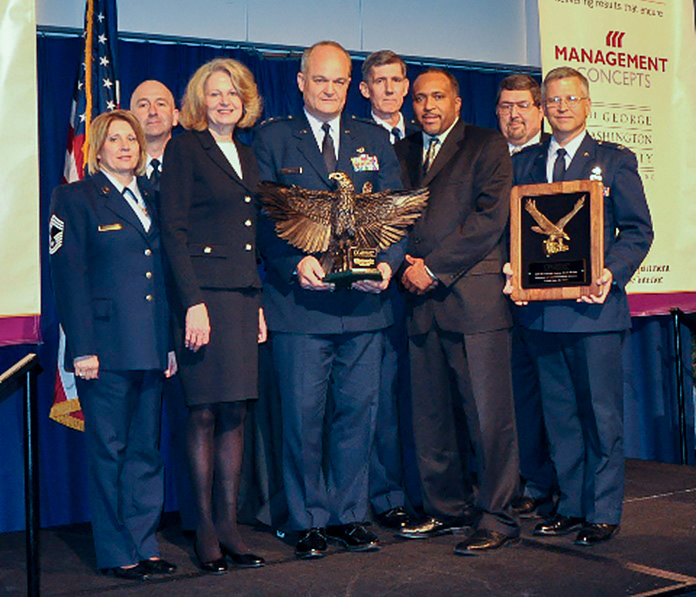
JAG Corps receiving the 2009 W. Edward Deming Outstanding Training Award. Lt Gen Jack Rives is in the center holding the eagle statue. (Air Force Judge Advocate General's Corps courtesy photo)
In 2010, the transformation continued with improvements to one of the flagship applications, AMJAMS. Initially, AMJAMS was a client-server application where each user’s computer would once a day communicate with the main JAS server. This often required work stoppages throughout the Air Force as the AMJAMS server was taken offline to update. However, technology specialists at JAS, partnered with contractors, transformed AMJAMS into a web application and gone were the days of having to wait for the system to come back online. In 2013, the AMJAMS trial court public docket came online allowing the public to see in real time upcoming courts-martial schedules. Other transformations included JAS building from the ground up a state-of-the-art global video teleconferencing network including a conference bridge and over 130 endpoint units.
Campus Learning Management System
In 2015, the CAPSIL learning management system gave way to Campus. Currently, Campus and Homeroom serve as The Air Force Judge Advocate General’s Corps’ learning management system for the administration, documentation, tracking, reporting, and delivery of Air Force legal specific educational courses, training programs, and learning and development programs. Campus and Homeroom are designed to identify training and learning gaps, utilizing analytical data and reporting. These systems, under the direction of AFJAGS, provide for in-residence courses, distance learning, blended learning, and both synchronous and asynchronous training.
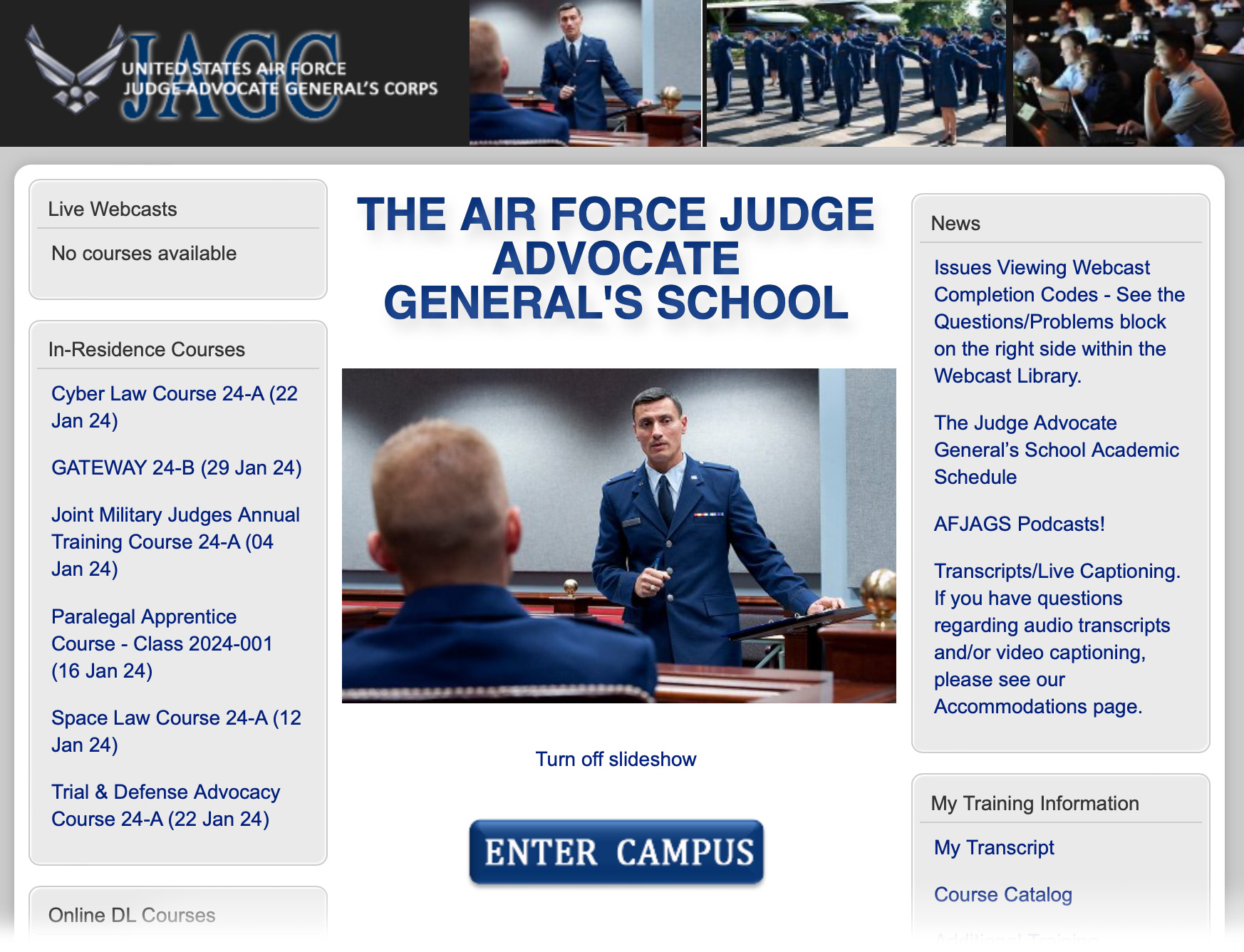
Campus Homeroom website (entrance page to Campus). (Air Force Judge Advocate General's Corps courtesy photo)
Force Multiplying Tools
JAS never lost its legal research mission. With the rise of commercial legal research tools, JAS has focused its efforts on force multiplying tools. However, even though FLITE was no longer the main source for most primary sources of law, in 2016 FLITE was reborn as FLITE Knowledge Management (KM). The first JAG Corps Director of Knowledge Management, Lieutenant Colonel Tamona L. Bright, assumed her duties in August 2020 and was responsible for “… capturing, distributing, and effectively using knowledge.”[15] FLITE KM has been capturing knowledge that is often lost when subject matter experts are unavailable or leave the Corps. FLITE KM again puts the curation of legal research materials in the hands of the experts and makes it available to all.
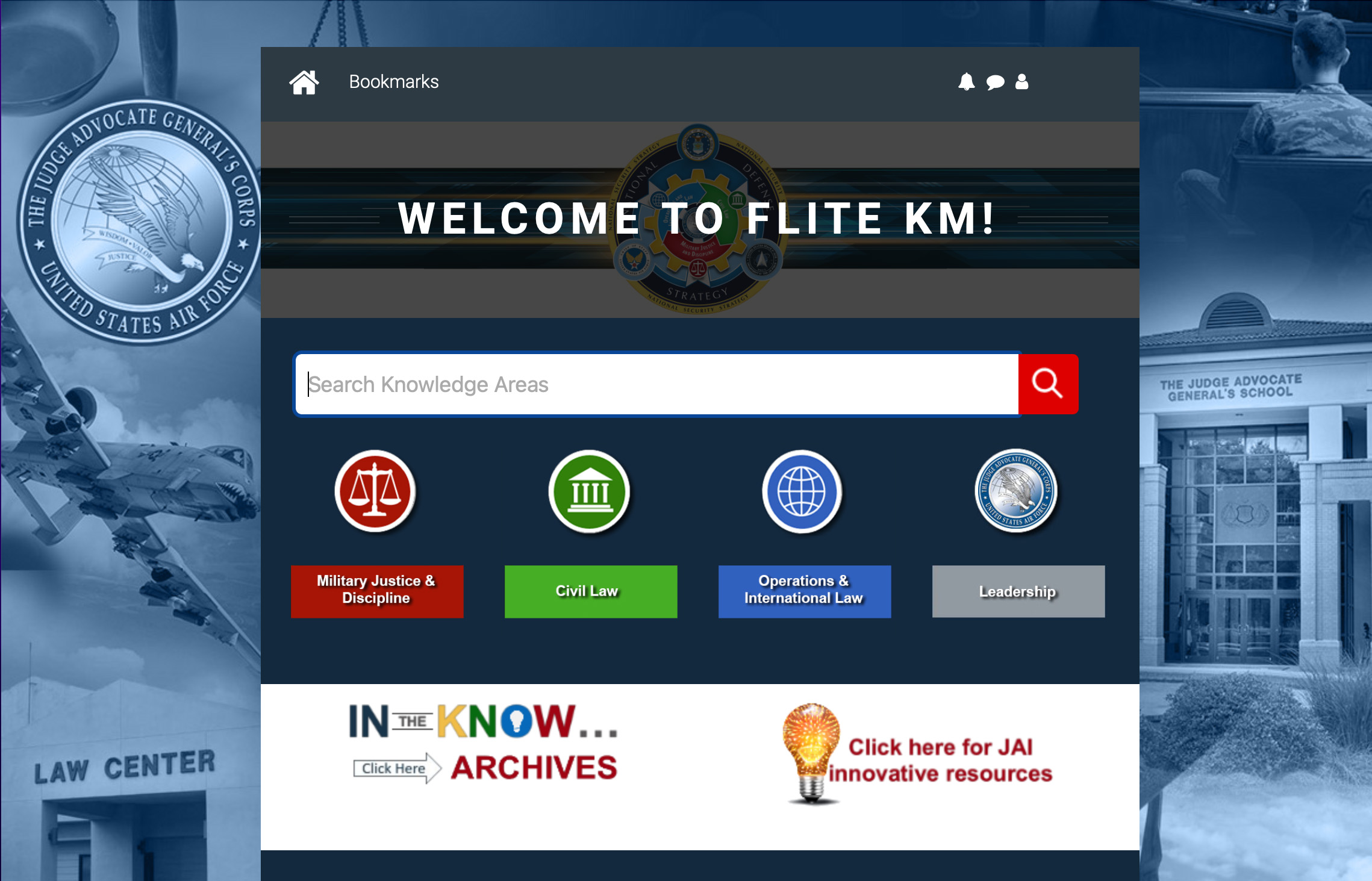
Present Day FLITE website. (Air Force Judge Advocate General's Corps courtesy photo)
In 2010, the Office of Management and Budget (OMB) launched the Federal Data Center Consolidation Initiative (FDCCI) to promote the use of green IT by reducing the overall energy and real estate footprint of government data centers; reduce the cost of data center hardware, software, and operations; increase the overall IT security posture of the Federal Government; and shift IT investments to more efficient computing platforms and technologies.[16] What this meant for JAS was that soon, they would no longer have servers sitting on their data floor. JAS embraced the challenge of a future where there would no longer be “touch maintenance” on a server, but rather a call to someone else managing those servers in the cloud. Thus began the digital transformation of taking legacy and dated applications and modernizing the case management portfolio. Starting with AMJAMS, the longest living and arguably the most important application for military justice and transforming it from a reporting tool into a true case management system that would assist users in the field while giving senior leadership necessary information is no small feat. AMJAMS’ successor, the Disciplinary Case Management System (DCMS), which launched on 20 September 2023, is a state-of-the-art case management system that will serve as the foundation for other modules, such as witness funding, administrative separation actions for both officers and enlisted, and the recent Congressionally-mandated Office of Special Trial Counsel.
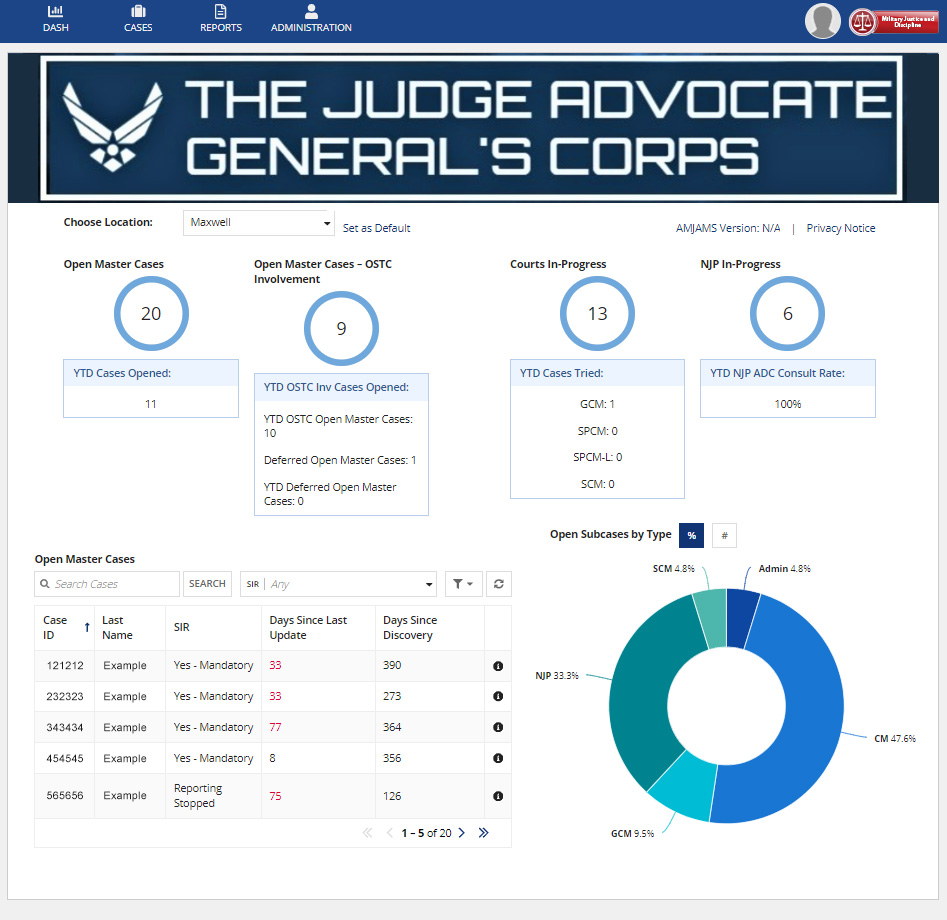
Screenshot of the Disciplinary Case Management System AMJAMS Module and a demo of the data generated. (Air Force Judge Advocate General's Corps courtesy photo)
To make all of this happen, JAS as an organization has also transformed. Gone are the days where attorneys would program and an application would only be released once it was completely finished. In addition to uniformed personnel, JAS is also home to a civilian team comprised of attorneys, programmers, system administrators, and an information assurance team. Recently, JAS now includes among its ranks civilian project managers who employ industry standard project management methodologies to build and field applications.
At the end of his article referencing the first 40 years of Air Force legal technology, Mr. Davis stated, “If the past four decades have taught us anything, it is that the train ride that will bring us the answers to these and other questions will certainly be an exciting one. All aboard, the Revolution continues.”[17] If nothing else, the continued story of the Air Force Legal Information Services has all the hallmarks of a great ride, and it does not look to be slowing anytime soon. The information technology revolution lives on and continues to transform the legal practice in the Air Force.
About the Author
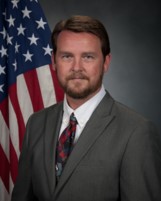
Mr. Rooker Mears, USAF
(B.S., Auburn University at Montgomery, Montgomery, Alabama; J.D., Samford University, Birmingham, Alabama) is the Chief, Legal Division, Legal Information Services Directorate, Maxwell Air Force Base, Alabama.
Edited by: Major Allison K.W. Johnson (Editor-in-Chief), Major Victoria H. Clarke, Major Andrew H. Woodbury and Technical Sergeant DeLacy Curl III
Layout by: Thomasa Huffstutler
Endnotes
[1] John Paul Davis,
Four Decades of Information Technology Excellence,
The Reporter Vol. 26,
Special History Edition, 166-171 (1999).
[10] Davis,
supra note 1.
[11] Blue Ribbon Panel, The Judge Advocate General’s 1982 Blue Ribbon Panel on Data Automation (1983) (on file with author).
[14] The term “CAPSIL” combined two Latin words,
captivitas, meaning to capture, and
consilium, meaning wisdom or knowledge. Together, these terms expressed CAPSIL’s purpose—to provide tools to harness the collective wisdom and knowledge of the JAG Corps.
[17] Davis,
supra note 1.